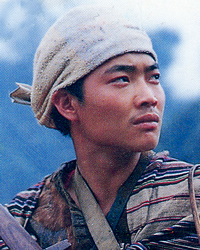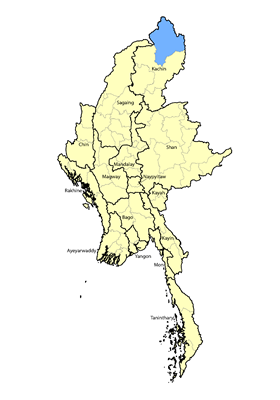Although few people know about the Drung in Myanmar, in China, where their name is spelled Derung, they have been recognized as one of that country's 55 official minority groups. When the American explorer Joseph Rock visited the Drung in the 1920s, he unflatteringly described them as “a primitive, harmless jungle people who live in trees like monkeys.” The Drung are related to the Anong tribe and claim they were once brothers who separated and were forced to live on different sides of a river. They are also culturally and linguistically related to the larger Rawang tribe who number over 70,000 people in northern Myanmar. The Drung in Myanmar are separated from their cousins in China by massive mountains and deep gorges that are impassable for most of the year. Due to isolation, the two communities have developed distinct identities and divergent dialects.
Location: The Drung, despite numbering just 300 people in the northern tip of Myanmar, are a proud and respected tribe. They dwell near Pannandin in the Putao District of Kachin State, near the juncture of Myanmar, China, and India. Two of their villages are Talatu and Khraung. More than 7,000 Drung people live across the border in China's Yunnan Province, primarily along the Dulong River Basin, while a small number live in the southern tip of Tibet. Drung territory has been described as “highly mountainous and rainfall is abundant. Virgin forests cover the mountain slopes, and wild animals abound.” The area is one of the most inaccessible on earth. When Prince Henri de Orléans passed through the Drung area in the 1890s he was overcome by the terrain and wrote: “We did not walk. We did not climb. It was gymnastics.”
Language: Because they did not have a written language, the Drung traditionally kept records by carving notches on wood or by tying knots. Although the spoken form of their language is used by all tribe members, literacy remains very low. Most Drung people can speak Burmese, Lisu, or Rawang as second languages.
A century ago, the Drung were divided into at least 15 patriarchal clans called nile, each of which consisted of several family communes. Each commune possessed its own territory, which was marked by boundaries such as streams and mountain ridges. Each clan was further divided into villages where people lived in common long houses and regarded themselves as the descendants of the same ancestor. The Drung gained notoriety for defeating a British military expedition in 1913, overcoming the colonialists' modern weapons with crossbows and staging ambushes.
Until a few decades ago, Drung girls tattooed their faces at the onset of puberty with designs according to their respective clans. The dead were formerly buried in hollow logs, except when death occurred because of a serious disease. In those cases, the corpses were cremated and the ashes thrown into a river.
For centuries, each Drung clan has had its own shaman who directed warfare and healed the sick. One scholar in Myanmar says of the Drung religious environment: “The village shaman is venerated as someone who can foretell the future. They have a custom of sending back the spirit of the dead. Also, they ask for compensation if someone violates their traditions. If the culprit is unable to pay, the whole family is liable on his behalf.”
The first missionary among the Drung was a French Catholic priest in 1907. The American Morse family came to the Drung area in the 1930s. Due to their persistent efforts, people from four villages accepted Christ and six churches were established.7 Today, just over half of the Drung people in Myanmar are estimated to be Christians, but on the Chinese side of the border there are fewer believers, and traditional animistic rituals continue to dominate. Due to their low rate of literacy, no Scripture has ever been translated into the Drung language.
Scripture Prayers for the Drung in Myanmar (Burma).
| Profile Source: Asia Harvest |











